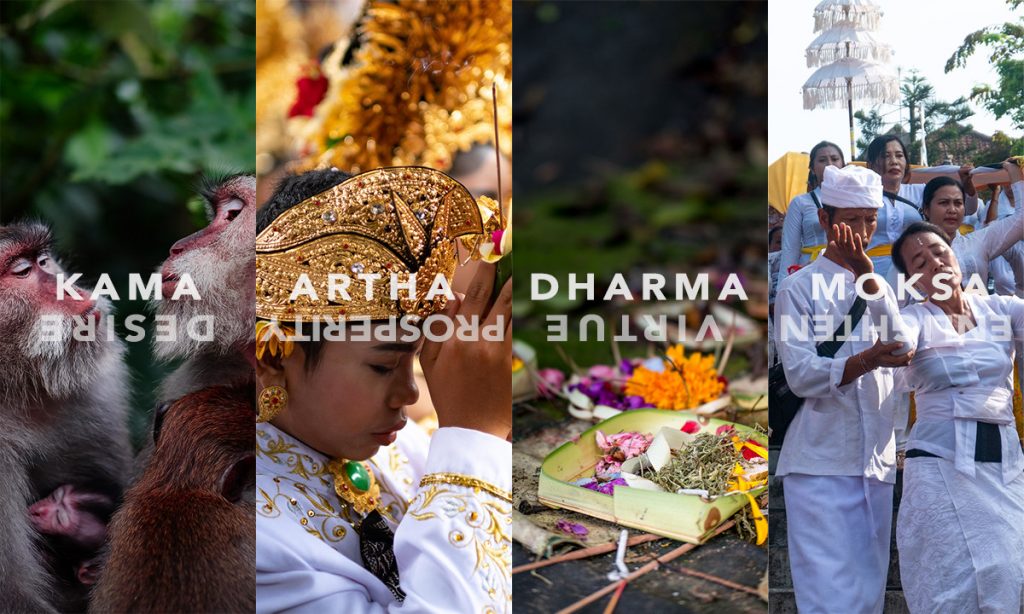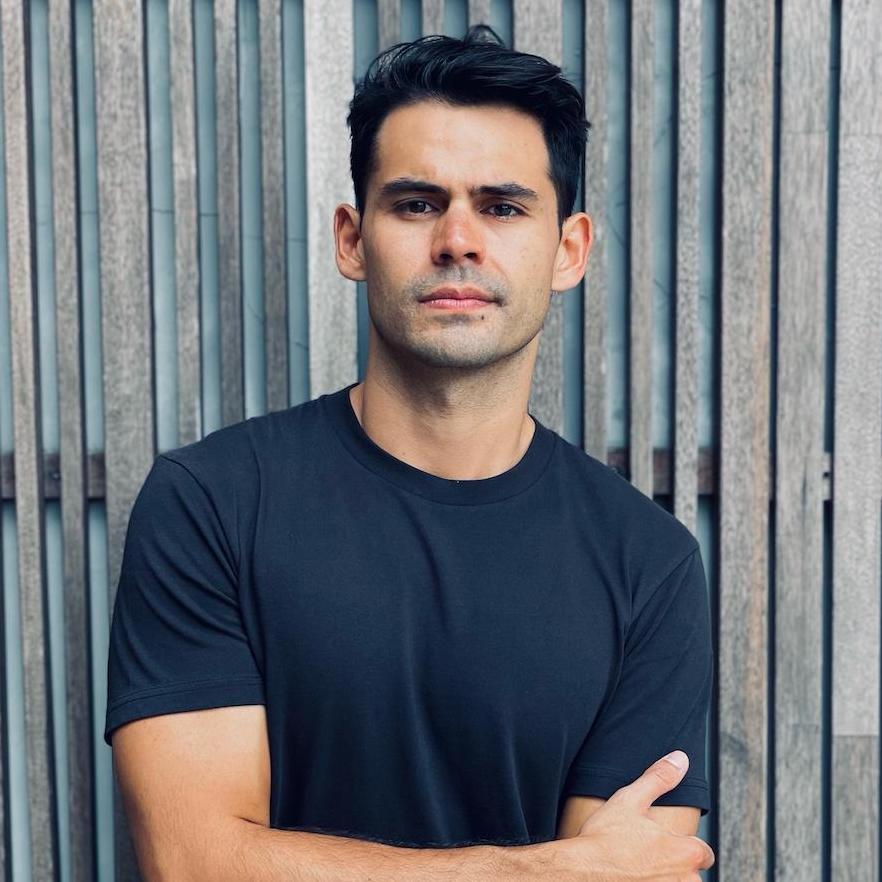“Rules for Life” have become popular book titles in the last few years, with psychologists, sociologist and even celebrities sharing their two-cents on what it takes to live a good life.
With that, this latest podcast episode shares what the Balinese Hindu ‘rules for life’ are, focusing on the Purusa Arta, the four principle ‘objects of human pursuit.’ Listen in as we take you through the goals of life, and how to attain them – the Balinese Hindu way.
Listen to Episode 10:
Available on your preferred Podcast Platform:
iTunes • Spotify • Google Podcasts • Pocket Casts • Radio Public
Listen and Read:

As always, Balinese beliefs and their way of life offer us ‘outsiders’ an interesting perspective on how we live or approach our own lives.
For the Hindu, not just Balinese but all Hindu, the goals of life are called the Purusa Artha – in Sanskrit this literally means the object of human pursuit.
There are four Purusa Artha in Hindu belief, but here in Bali there are layers to achieve this. It is these layers that make this subject so incredibly complex. This is the first layer. The second layer would be the Panca Yadnya, five sacrifices or offerings — I would liken these to commandements. Within these five sacrifices are the rites and actions we must do to achieve the layers above. I would liken this to prayers and baptisms, for example.
Once again, the goal of not only human life but our very soul is to achieve moksa, ultimate enlightenment, when our soul, bhawana alit, the microcosm, can become one with the universe, bhwana agung, the macrocosm. Moksa is the last of the life goals, or Purusa Artha.
The other three, are dharma, Artha and kama. Words you may have heard before.
Dharma refers to balance and is at the very centre of Hindu philosophy. It governs what is harmony and therefore what kharma, or actions, must be completed to achieve balance. Each person has a duty in keeping order in the universe. This manifests in many ways.
Then we have artha, which can be translated as prosperity. This can be misinterpreted as pure materialism, but should be seen as a means to an end, Artha enables us to do live fully and also do what is required spiritually — more on this later.
Finally we have kama, which you recognise from the ever-famous kama-sutra. It is the nature of desire, which is seen as an important part of enjoying the offerings of life, the value of life and understanding its impermanence. It has often been bastardised to be something as purely erotic, but it goes beyond this and kama can be desire, love, passion — all the things that give life meaning.
Perhaps on their own, Artha and kama seem sinful and vice-filled, but what’s important is that both of these must be done with the consideration of dharma. Considering the limits of what is right. Yes, you can acquire wealth and better yourself, but not to the point of greed, not to the point where you may exploit others. Yes you can desire someone, but if they don’t desire you or if you are committed to another, make sure your actions or kharma are in line with what is right. All actions must create balance in the universe.
So that is the first layer, the four goals of life. And to break this down, in Bali we have the second layer, the Panca Yadnya, basically the commandments basically that tell you what you need to do.
These Five Sacrifices, or Offerings are as follows:
The first is Dewa Yadnya, sacrifice to the gods. In which you promise to pray and offer your services, this includes committing to your daily offerings, joining full moon, temple, and auspicious day ceremonies, it includes practicing religious teachings.
The next is Pitra Yadnya, your sacrifice to spirits and ancestors. These means you must pay respects to those who came before you, for they give us life, but also to our elders and parents. This means respecting their word, caring for them and importantly promising to carry out their cremation ceremony so that they may enter their next phase in life successfully. It is a cycle, our parents care for us, and in return, we promise to send their soul, or atma, to the afterlife — and we hope too that our children will do the same for us.
Third is Rsi Yadnya, respecting the holy people and holy works. This can consist of helping the priestly, helping to build shrines and temples, contributing to the welfare of the religious structures.
Fourth is the Manusa Yadnya, Human Offerings or sacrifices. This means the Balinese hindu promise to complete the rites of passage that every human must go through. There are 13 in total and this starts when the baby is still in the womb, right up to marriage, and sometimes beyond. More on this later.
Finally is the Bhuta Yadnya, sacrifices for the negative forces, the Bhuta and kala. Why? Well as we discussed in a previous episode, Bali is all about balance and the negative forces must be given respect and offerings in order to placate them and allow harmony in the world — this also allows for humans to carry out their way of life in peace. This is done at all scales, from the daily mecaru offerings, to the cenential Eka dasa rudra ceremony for a giant universal cleansing held at Besakih Temple.
That is the second layer, the third layer is the breaking down of each of the Panca Yadnya and committing to the actions required within them. All of these interlock together, guiding us in actions that help to create balance in the universe.
The elements in each panca yadnya help us to achieve the four goals of kama, Artha and dharma, and if all goes well, moksa. For example, by following the rules of Dewa Yadnya, offerings to the gods, one is fulfilling their dharma duties.
But at the same time, striving to achieve our four goals can also help us to achieve the panca yadnya. For example, achieving Artha or wealth in life gives one the means to create better ceremonies, elaborate cremations for parents and perhaps even help to maintain a temple. As you may have seen in Bali, as the economy improves, the ceremonies become more elaborate. By having more, one can give more.
The Manusia Yadnya, or human rites of passage are also important in helping one achieve the four goals of life.
As mentioned, The first ceremony takes place around 6 months after conception, called the Pegedong-gedongan. This is done when the foetus takes a human form – it is a kind of purification for the baby and its life in the future.
Following this are numerous ceremonies for the baby, including:
Kepus Pengsed, when the baby’s umbilical cord falls off. It marks the moment when the physical connection to the baby’s kanda empat (spiritual siblings that are the anchor to each person’s life on earth) is broken, and the connection becomes purely spiritual. The Kanda Empat are complex too, and will require a longer explanation which I won’t go into here.
12 days after the baby is born, another ceremony takes place called ngelepas hawon. This is the first time the baby receives holy water and is often when a Balian or shaman will determine which of the family’s ancestors soul has reincarnated into the newborn.
After three-months, the baby will receive its name during the telubulan (meaning three months) ceremony. This will often be a large ceremony, with a feast.
Next is the otonan, the Balinese birthday, held every 6 months following the Balinese calendar. The first otonan is very significant as this will be the very first time the baby has touched the ground. This moment marks the baby as a human, and thus the ceremony aims to give the child the spiritual strength it needs in this world.
Perhaps the most well-known rite of passage are the mepandes or metatah, the teeth filing, usually done during adolescents. This crucially important rite includes the flattening of a person’s canines, symbolic of animalistic behaviour and thus the removal of the sad ripu or 6 negative characteristics of human life. These include lust, greed, anger, drunkenness, confusion and jealousy — not dissimilar to Christianty’s seven deadly sins.
By doing this, one is less tempted, and more likely to live by the rules of dharma, of virtue. It helps one to control their kama, or desires, and thus begin their focus on Artha or prosperity.
This is a good moment to give some chronology into how the purusa Artha (four life goals) may play out in a human lifetime.
When we are young, we are free and open to explore life, to enjoy our desires (kama). Then, at the end of our adolescent life, with the filing of teeth, this signals the reduction of ones desires. One might get married, settle down, and thus focus on artha, prosperity. With prosperity one can then contribute to their duties to gods, priests, parents and their children (thus three of the panca yadnya, but also dharma), paying for grand cremations and giving parents the send-off they deserve, and giving children the best rites of passage money canbuy. Then, once one has had their fill of kama, and then contributed enough with their artha, old age comes and they can focus on the religious, the purely dharma, in hopes of achieving moksa.
—
Okay, that is the life of a Balinese Hindu. How does this have anything to do with my life? Well there are some key take-aways here that I think all of us, Hindu or not, religious or not, can apply to our own lives.
Firstly, I love this chronology of the human life. Our youth, that’s for desire, exploration, passion, exploring and enjoying the thrills of life. Discovering what makes it meaningful.
Our next stage, yes we can have all of those things, but maybe at a smaller scale, and we can start to think of prosperity. Not for us, but so that we in our later years can actually give back to those who have given to us. Even in the Balinese ceremonies there is a cycle of giving with the understanding that others will look after us when we are in need. Parents will pay for otonans and metatah ceremonies for their children to prepare them for this world, in return, their children will promise their parents great cremations to help them find the best path out of this world.
The next part of after all of that, yes we have can enjoy kama and strive for artha, but why not focus on the bigger things, beyond the material enjoyments of life. Even if you aren’t religious, perhaps it is the wisdom of life, is this something you can give to someone? Can you teach the virtues and life lessons you have learnt to someone?
All in all, the first layer, the goals of life, of human virtue, of enjoying life, of finding a means for life, I think we can all agree that together, they are a pretty good recipe for a pretty good life. And whether or not you believe in enlightenment, or heaven, your moksa can simply be looking back on your deathbed and saying to yourself, “damn, that was a pretty good ride.”
Follow us on all major podcast platforms (iTunes • Spotify • Google Podcasts • Pocket Casts • Radio Public) or check out more Podcast Episodes here.










